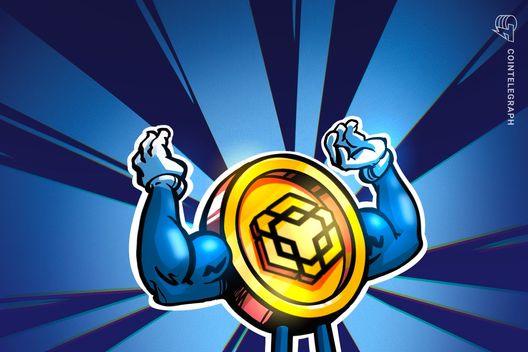
October has historically been one of the best-performing months for Bitcoin (BTC), but this year BNB (BNB) has taken center stage.
“Uptober” (a term coined to describe Bitcoin’s typically bullish month of October) began to perform well this year, just as the U.S. government shutdown began. Now, with Washington’s funding stalemate going on for more than three weeks, that optimism has faded amid trade tensions and the fallout from a historic liquidation scandal.
Meanwhile, BNB, the native token of Binance’s BNB Chain, has hit new all-time highs twice this month. The network is experiencing a surge in meme coin transactions and directly competes with Hyperliquid in the decentralized perpetual market through the Aster platform.
BNB has since retreated from its all-time high, but has continued to rise about 6% since the beginning of October. But these gains come against the backdrop of increased scrutiny over Binance’s alleged role in the recent market crash.
Binance’s BNB, Meme Coin Season Accelerates Indicators
Solana has long been the go-to network for memecoins. This is largely thanks to the token launch pad Pump.fun. But in October, that dominance was challenged by a new wave of BNB chain-based tokens.
On October 4, Binance co-founder Changpeng Zhao reportedly changed his cryptocurrency wallet from $3,000 to $2 million after he shared a post about meme coins. This moment coincided with the beginning of the memecoin craze on the BNB chain.
On October 1st, Pump.fun accounted for 93.3% of all meme coins issued between the two platforms. By the day of Zhao’s post, that share had fallen to 56.2%. A week later, on October 8th, BNB Chain’s Four.meme tipped the balance with 83.9% of new token issuance, surpassing Pump.Fun’s daily revenue generation. BNB hit a new all-time high of over $1,300.
During Four.meme’s early October surge, blockchain analysis platform Bubble Map reported that 100,000 traders bought the new BNB chain meme coin, earning a 70% profit.
This momentum also lifted the network’s broader metrics. Despite a decline in on-chain activity across the industry, BNB Chain led all blockchains in total fees and ranked second in active addresses and transactions over the past week, according to Nansen data.
Shortly after, the crypto market suffered one of the largest liquidation events in history, wiping out $19 billion in positions and wiping out approximately $450 billion from total market capitalization.
Related: $19 Billion Crypto Market Crash: Was It Leverage, Chinese Tariffs, or Both?
After the crash, BNB Chain rewarded meme coin traders with a $45 million airdrop round.
BNB Chain DEX Aster data drama and Binance technical glitch
BNB is enjoying a historic month as Bitcoin struggles to recover from its recent liquidation spree, while Binance fends off mounting criticism about its role in the crash.
One of the main allegations focused on a malfunction in the price oracle, which briefly showed that Ethena’s synthetic dollar, USDe, lost its dollar peg on Binance, even though prices elsewhere remained stable.
Delphi Digital analyst Trevor King said Binance values wrapped assets such as wBETH, BNSOL, and USDe based on the exchange’s own spot prices rather than redemption prices. This made the collateral appear weaker than it actually was. Because Binance’s oracles served as the de facto “record price” across leveraged trading platforms, the mispricing spread to other platforms as well. King also added that a broader market downturn had already begun before the mispricing appeared on Binance.
In the aftermath, several X users claimed to have suffered losses due to Binance’s system issues that day. One of the viral posts came from the account 812.eth, which cited a “friend of the market maker” and claimed that as prices fell, orders were repeatedly rejected on Binance, increasing losses. The post has since been deleted.
Binance denied the cause of the selloff, attributing the broader market decline to US President Donald Trump’s threat to impose 100% tariffs on imports from China. The exchange acknowledged that it had “temporarily experienced a technical glitch in some platform modules” and that “rapid market fluctuations caused pegging issues with certain assets.” Binance said it ultimately distributed $283 million in compensation. Despite the turmoil, BNB surged again, hitting a new all-time high of $1,370 on October 13th.
In its day, Hyperliquid was the top platform for liquidation. The fast-growing perpetual decentralized exchange (DEX) is currently facing a rival in BNB Chain’s Aster.
Related: Aster delisting reveals DeFi’s growing integrity crisis
On October 6th, Aster led all perpetual DEXs with an impressive 24-hour trading volume of $41.78 billion. However, DefiLlama later removed Aster’s data, citing concerns about the integrity of the index. The platform was quietly relisted, but DefiLlama founder 0xngmi said the numbers could not be verified yet.
BNB turns Bitcoin’s ‘Uptober’ into its own victory lap
October was Bitcoin month, but this year the spotlight has shifted to the Binance ecosystem.
A surge in meme coin trading, new incentives, and the rise of Aster have pushed BNB to record highs, defying a market weighed down by historic liquidations and international trade tensions.
While Bitcoin has so far slumped after overcoming its worst October in over a decade, network activity and fee generation on the BNB chain continues to rise.
The momentum wasn’t perfect. Binance has once again been under the microscope due to the price oracle glitch, leading to renewed scrutiny of how centralized its ecosystem really is.
Astor’s short-term removal from DeFirama only added to the skepticism about how the numbers stack up. But despite these visible cracks, BNB is poised to turn a quiet month for cryptocurrencies into one of the strongest performances of the year.
magazine: Back to Ethereum: How Synthetix, Ronin and Celo saw the light


